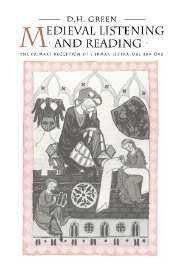Book contents
- Frontmatter
- Contents
- Preface
- List of abbreviations
- PART I Preliminary problems
- PART II Three modes of reception
- Introduction
- 3 Criteria for reception by hearing
- 4 Survey of reception by hearing
- 5 Criteria for reception by reading
- 6 Survey of reception by reading
- 7 Criteria for the intermediate mode of reception
- 8 Survey of the intermediate mode of reception
- PART III Conclusions
- Appendix Middle High German ‘lesen’ = ‘to narrate, recount, tell’
- Notes
- Bibliographical index
- Index of names
5 - Criteria for reception by reading
Published online by Cambridge University Press: 04 September 2009
- Frontmatter
- Contents
- Preface
- List of abbreviations
- PART I Preliminary problems
- PART II Three modes of reception
- Introduction
- 3 Criteria for reception by hearing
- 4 Survey of reception by hearing
- 5 Criteria for reception by reading
- 6 Survey of reception by reading
- 7 Criteria for the intermediate mode of reception
- 8 Survey of the intermediate mode of reception
- PART III Conclusions
- Appendix Middle High German ‘lesen’ = ‘to narrate, recount, tell’
- Notes
- Bibliographical index
- Index of names
Summary
If oral communication rests on the presence of a speaker and at least one listener, together forming a group, written communication normally separates them and sees them as individuals (even if the author does not write himself, but dictates to a scribe, he is still separated from the reader who, even if he reads in or to a group, is separated from the writer). Written communication, freed from the restriction to shared time and place to which the spoken word is tied, can extend to past and future, but also to other places, yet suffers the drawback that deictic pointers intelligible in face-to-face communication are now excluded and have to be replaced by explicit linguistic references. This applies also to non-verbal aspects of oral communication: visual ones, like miming or gestures, cannot be conveyed in writing, whilst acoustic ones, such as intonation or accentuation, have been captured partially in writing, and even then only by means of modern typographic devices. This greater explicitness forced on the writer if he is to achieve what the speaker does in front of his listeners is unavoidable in another respect, for the potential element of give-and take dialogue in direct oral encounter is missing from writing. A written text remains silent beyond what is written and cannot be asked questions by its reader (this was the gist of Plato's criticism of writing), so that the careful writer has to anticipate such questions and write his answers into his text in advance. On the other hand, his medium makes it easier to do this.
- Type
- Chapter
- Information
- Medieval Listening and ReadingThe Primary Reception of German Literature 800–1300, pp. 113 - 149Publisher: Cambridge University PressPrint publication year: 1994



